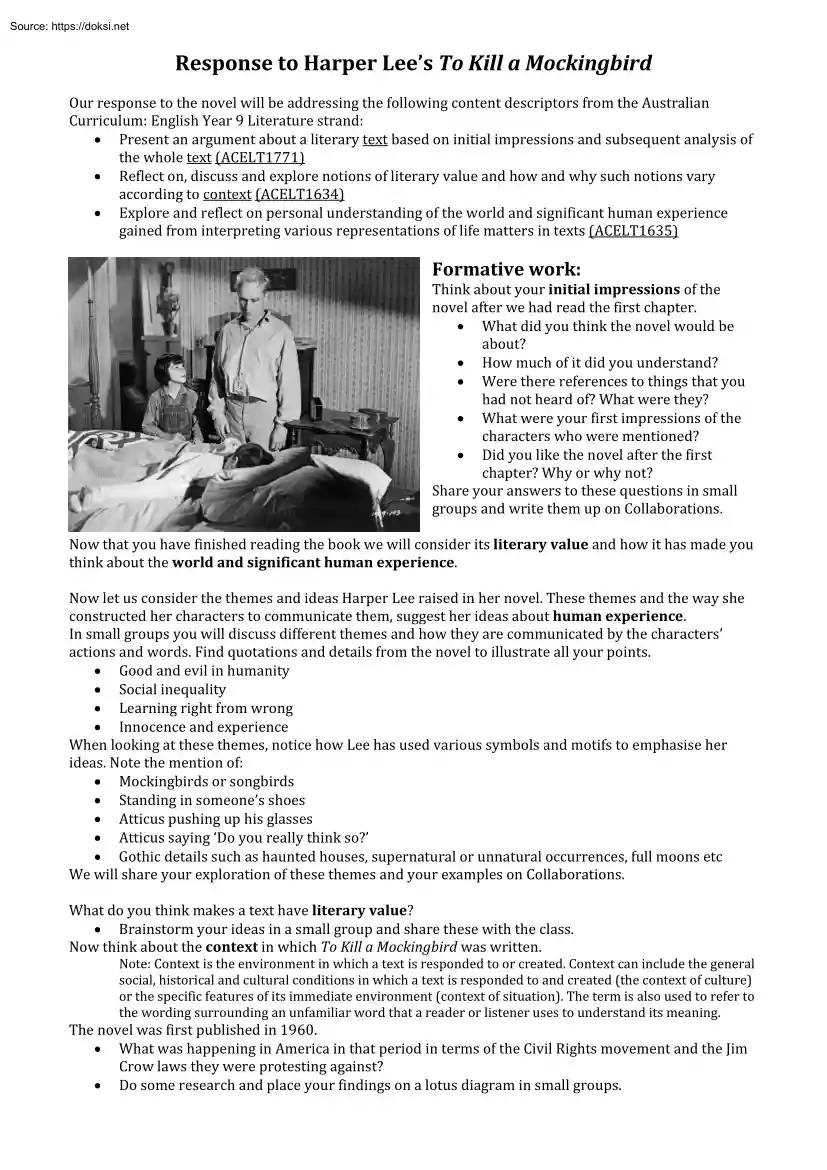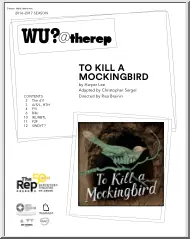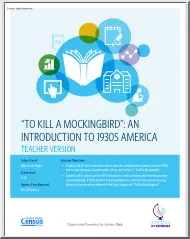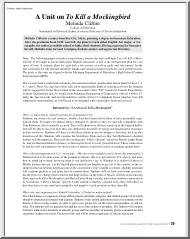A doksi online olvasásához kérlek jelentkezz be!

A doksi online olvasásához kérlek jelentkezz be!
Nincs még értékelés. Legyél Te az első!
Mit olvastak a többiek, ha ezzel végeztek?
Tartalmi kivonat
Response to Harper Lee’s To Kill a Mockingbird Our response to the novel will be addressing the following content descriptors from the Australian Curriculum: English Year 9 Literature strand: • Present an argument about a literary text based on initial impressions and subsequent analysis of the whole text (ACELT1771) • Reflect on, discuss and explore notions of literary value and how and why such notions vary according to context (ACELT1634) • Explore and reflect on personal understanding of the world and significant human experience gained from interpreting various representations of life matters in texts (ACELT1635) Formative work: Think about your initial impressions of the novel after we had read the first chapter. • What did you think the novel would be about? • How much of it did you understand? • Were there references to things that you had not heard of? What were they? • What were your first impressions of the characters who were mentioned? • Did you like
the novel after the first chapter? Why or why not? Share your answers to these questions in small groups and write them up on Collaborations. Now that you have finished reading the book we will consider its literary value and how it has made you think about the world and significant human experience. Now let us consider the themes and ideas Harper Lee raised in her novel. These themes and the way she constructed her characters to communicate them, suggest her ideas about human experience. In small groups you will discuss different themes and how they are communicated by the characters’ actions and words. Find quotations and details from the novel to illustrate all your points • Good and evil in humanity • Social inequality • Learning right from wrong • Innocence and experience When looking at these themes, notice how Lee has used various symbols and motifs to emphasise her ideas. Note the mention of: • Mockingbirds or songbirds • Standing in someone’s shoes •
Atticus pushing up his glasses • Atticus saying ‘Do you really think so?’ • Gothic details such as haunted houses, supernatural or unnatural occurrences, full moons etc We will share your exploration of these themes and your examples on Collaborations. What do you think makes a text have literary value? • Brainstorm your ideas in a small group and share these with the class. Now think about the context in which To Kill a Mockingbird was written. Note: Context is the environment in which a text is responded to or created. Context can include the general social, historical and cultural conditions in which a text is responded to and created (the context of culture) or the specific features of its immediate environment (context of situation). The term is also used to refer to the wording surrounding an unfamiliar word that a reader or listener uses to understand its meaning. The novel was first published in 1960. • What was happening in America in that period in terms of the
Civil Rights movement and the Jim Crow laws they were protesting against? • Do some research and place your findings on a lotus diagram in small groups. Now that you know the novel’s context, think about the people who would have read it in America. • Which groups of people do you think would regard the novel as having literary value and which groups might not? Why or why not? Consider your own context, living in Australia in the early 21st Century and your beliefs about the issues raised by the novel. Look again at your ideas about what makes a text have literary value. • Now explain whether you think To Kill a Mockingbird has literary value and why. Now let us revisit your first impressions of the novel. How much have they changed now that you have read the novel and analysed various aspects of it? • Discuss your opinions about the novel with a partner. Summative task: Now you are ready to write your overall response to Harper Lee’s To Kill a Mockingbird. Choose
one of the following options and write 350-500 words in response to it: 1. Write a letter to a friend explaining why they should persevere with reading To Kill a Mockingbird despite not liking it after the first few chapters. Support your points with specific details and quotations from the novel, without giving away too much of the plot. 2. Write a letter to the Head of English explaining your opinion of To Kill a Mockingbird’s literary merit and why you think it should or should not be studied by Year 9 students at our school. Support your points with specific details and quotations from the novel. 3. Write a personal response to the novel, explaining what you learned from reading it about particular aspects of the world and human experience. Support your insights with specific details and quotations from the novel. Relevant Year 9 Achievement Standards by which you will be assessed: Evaluate and integrate ideas and information from texts to form their own interpretations.
Evident by: • Your own interpretation of the novel is clearly explained, building on the notes recorded in your group work. Select evidence from the text to analyse and explain how language choices and conventions are used to influence an audience. Evident by: • You support your points with specific details and quotations from the novel. • You comment on the effect these quotations and details have on the reader. Edit for effect, selecting vocabulary and grammar that contribute to the precision and persuasiveness of texts and using accurate spelling and punctuation. Evident by: • You use the appropriate level of formality in your vocabulary and style to suit your implied audience • You write precisely, avoiding generalisations and misinformation • You write persuasively, using words that encourage your reader to agree with your opinions • You use accurate spelling, carefully proof reading your work and not just relying on the computer’s spellchecker • You punctuate
your sentences correctly, avoiding comma splices, sentence fragments and misused apostrophes. How to use and integrate quotations Have a look at these quotations from the novel: ‘First of all,’ he said, if you can learn a simple trick, Scout, you’ll get along better with all kinds of folks. You never really understand a person until you consider things from his point of view –’ ‘Sir?’ ‘– until you climb into his skin and walk around in it.’ (Chapter 3, p.31) Atticus said to Jem one day, ‘I’d rather you shot at tin cans in the back yard, but I know you’ll go after birds. Shoot all the bluejays you want, if you can hit ’em, but remember it’s a sin to kill a mockingbird.’ That was the only time I ever heard Atticus say it was a sin to do something, and I asked Miss Maudie about it. ‘Your father’s right,’ she said. ‘Mockingbirds don’t do one thing but make music for us to enjoy They don’t eat up people’s gardens, don’t nest in corncribs,
they don’t do one thing but sing their hearts out for us. That’s why it’s a sin to kill a mockingbird.’ (Chaper 10, p98) These are really useful and significant quotations which you could use in your assignment, but you need to integrate them smoothly into your points and make them illustrate and support your argument. First of all, work out what point you want to make. Then find a quotation to help prove/support it. If it is long, then you only want to quote a fragment of it. Don’t quote huge slabs Start with your point and then integrate your quotation into the flow of the sentence, including any necessary elements of its context (who said it, in what circumstances) so that it makes sense. Look at this example: Harper Lee teaches us many lessons through the novel To Kill A Mockingbird. She communicates the importance of empathy and understanding other people’s perspectives through Atticus telling Scout, ‘You never really understand a person until you consider things
from his point of view until you climb into his skin and walk around in it.’ This lesson in relation to Scout’s interaction with her teacher Miss Caroline is revisited at the novel’s end when Scout stands on Boo Radley’s porch and finally understands how he felt towards them and why he rescued them from Bob Ewell’s attack: ‘Summer, and he watched his children’s heart break. Autumn again, and Boo’s children needed him.’ In this example the context of each quotation is clear, that is, Atticus is telling Scout the moral lesson he wants her to learn, and Scout considering Boo’s perspective. An ellipsis is used () to show missing words from the quotation. The novel’s title is italicized You may choose to italicize your quotations or not, but whatever you do, be consistent. The first quotation is embedded into the sentence The second quotation is introduced using a colon. Let us look at another example: Lee also uses effective symbolism when writing about how,
‘it’s a sin to kill a mockingbird.’ Atticus advising the children of this when they are given guns for Christmas, later becomes symbolic of all the good people in the novel who are persecuted by society, such as Tom Robinson and Boo Radley. As Miss Maudie says, mockingbirds just ‘make music for us to enjoy’ and ‘sing their hearts out for us.’ Similarly, Tom and Boo did their best to help others, Tom by helping Mayella, and Boo by saving Scout and Jem from Bob Ewell’s deadly attack. Here, the best bits of this long quotation have been integrated into the paragraph and their context is clear, as well as their wider symbolic significance
the novel after the first chapter? Why or why not? Share your answers to these questions in small groups and write them up on Collaborations. Now that you have finished reading the book we will consider its literary value and how it has made you think about the world and significant human experience. Now let us consider the themes and ideas Harper Lee raised in her novel. These themes and the way she constructed her characters to communicate them, suggest her ideas about human experience. In small groups you will discuss different themes and how they are communicated by the characters’ actions and words. Find quotations and details from the novel to illustrate all your points • Good and evil in humanity • Social inequality • Learning right from wrong • Innocence and experience When looking at these themes, notice how Lee has used various symbols and motifs to emphasise her ideas. Note the mention of: • Mockingbirds or songbirds • Standing in someone’s shoes •
Atticus pushing up his glasses • Atticus saying ‘Do you really think so?’ • Gothic details such as haunted houses, supernatural or unnatural occurrences, full moons etc We will share your exploration of these themes and your examples on Collaborations. What do you think makes a text have literary value? • Brainstorm your ideas in a small group and share these with the class. Now think about the context in which To Kill a Mockingbird was written. Note: Context is the environment in which a text is responded to or created. Context can include the general social, historical and cultural conditions in which a text is responded to and created (the context of culture) or the specific features of its immediate environment (context of situation). The term is also used to refer to the wording surrounding an unfamiliar word that a reader or listener uses to understand its meaning. The novel was first published in 1960. • What was happening in America in that period in terms of the
Civil Rights movement and the Jim Crow laws they were protesting against? • Do some research and place your findings on a lotus diagram in small groups. Now that you know the novel’s context, think about the people who would have read it in America. • Which groups of people do you think would regard the novel as having literary value and which groups might not? Why or why not? Consider your own context, living in Australia in the early 21st Century and your beliefs about the issues raised by the novel. Look again at your ideas about what makes a text have literary value. • Now explain whether you think To Kill a Mockingbird has literary value and why. Now let us revisit your first impressions of the novel. How much have they changed now that you have read the novel and analysed various aspects of it? • Discuss your opinions about the novel with a partner. Summative task: Now you are ready to write your overall response to Harper Lee’s To Kill a Mockingbird. Choose
one of the following options and write 350-500 words in response to it: 1. Write a letter to a friend explaining why they should persevere with reading To Kill a Mockingbird despite not liking it after the first few chapters. Support your points with specific details and quotations from the novel, without giving away too much of the plot. 2. Write a letter to the Head of English explaining your opinion of To Kill a Mockingbird’s literary merit and why you think it should or should not be studied by Year 9 students at our school. Support your points with specific details and quotations from the novel. 3. Write a personal response to the novel, explaining what you learned from reading it about particular aspects of the world and human experience. Support your insights with specific details and quotations from the novel. Relevant Year 9 Achievement Standards by which you will be assessed: Evaluate and integrate ideas and information from texts to form their own interpretations.
Evident by: • Your own interpretation of the novel is clearly explained, building on the notes recorded in your group work. Select evidence from the text to analyse and explain how language choices and conventions are used to influence an audience. Evident by: • You support your points with specific details and quotations from the novel. • You comment on the effect these quotations and details have on the reader. Edit for effect, selecting vocabulary and grammar that contribute to the precision and persuasiveness of texts and using accurate spelling and punctuation. Evident by: • You use the appropriate level of formality in your vocabulary and style to suit your implied audience • You write precisely, avoiding generalisations and misinformation • You write persuasively, using words that encourage your reader to agree with your opinions • You use accurate spelling, carefully proof reading your work and not just relying on the computer’s spellchecker • You punctuate
your sentences correctly, avoiding comma splices, sentence fragments and misused apostrophes. How to use and integrate quotations Have a look at these quotations from the novel: ‘First of all,’ he said, if you can learn a simple trick, Scout, you’ll get along better with all kinds of folks. You never really understand a person until you consider things from his point of view –’ ‘Sir?’ ‘– until you climb into his skin and walk around in it.’ (Chapter 3, p.31) Atticus said to Jem one day, ‘I’d rather you shot at tin cans in the back yard, but I know you’ll go after birds. Shoot all the bluejays you want, if you can hit ’em, but remember it’s a sin to kill a mockingbird.’ That was the only time I ever heard Atticus say it was a sin to do something, and I asked Miss Maudie about it. ‘Your father’s right,’ she said. ‘Mockingbirds don’t do one thing but make music for us to enjoy They don’t eat up people’s gardens, don’t nest in corncribs,
they don’t do one thing but sing their hearts out for us. That’s why it’s a sin to kill a mockingbird.’ (Chaper 10, p98) These are really useful and significant quotations which you could use in your assignment, but you need to integrate them smoothly into your points and make them illustrate and support your argument. First of all, work out what point you want to make. Then find a quotation to help prove/support it. If it is long, then you only want to quote a fragment of it. Don’t quote huge slabs Start with your point and then integrate your quotation into the flow of the sentence, including any necessary elements of its context (who said it, in what circumstances) so that it makes sense. Look at this example: Harper Lee teaches us many lessons through the novel To Kill A Mockingbird. She communicates the importance of empathy and understanding other people’s perspectives through Atticus telling Scout, ‘You never really understand a person until you consider things
from his point of view until you climb into his skin and walk around in it.’ This lesson in relation to Scout’s interaction with her teacher Miss Caroline is revisited at the novel’s end when Scout stands on Boo Radley’s porch and finally understands how he felt towards them and why he rescued them from Bob Ewell’s attack: ‘Summer, and he watched his children’s heart break. Autumn again, and Boo’s children needed him.’ In this example the context of each quotation is clear, that is, Atticus is telling Scout the moral lesson he wants her to learn, and Scout considering Boo’s perspective. An ellipsis is used () to show missing words from the quotation. The novel’s title is italicized You may choose to italicize your quotations or not, but whatever you do, be consistent. The first quotation is embedded into the sentence The second quotation is introduced using a colon. Let us look at another example: Lee also uses effective symbolism when writing about how,
‘it’s a sin to kill a mockingbird.’ Atticus advising the children of this when they are given guns for Christmas, later becomes symbolic of all the good people in the novel who are persecuted by society, such as Tom Robinson and Boo Radley. As Miss Maudie says, mockingbirds just ‘make music for us to enjoy’ and ‘sing their hearts out for us.’ Similarly, Tom and Boo did their best to help others, Tom by helping Mayella, and Boo by saving Scout and Jem from Bob Ewell’s deadly attack. Here, the best bits of this long quotation have been integrated into the paragraph and their context is clear, as well as their wider symbolic significance




 Ahogy közeledik a történelem érettségi, sokan döbbennek rá, hogy nem készültek fel eléggé az esszéírás feladatra. Módszertani útmutatónkban kitérünk a történet térbeli és időbeli elhelyezésére, a források elemzésére és az eseményeket alakító tényezőkre is.
Ahogy közeledik a történelem érettségi, sokan döbbennek rá, hogy nem készültek fel eléggé az esszéírás feladatra. Módszertani útmutatónkban kitérünk a történet térbeli és időbeli elhelyezésére, a források elemzésére és az eseményeket alakító tényezőkre is.